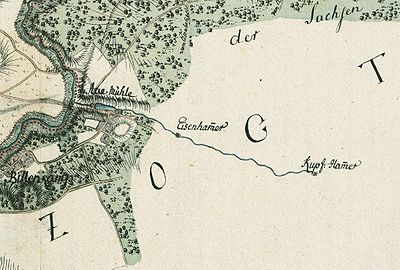Black Au
| Black Au | ||
|
Fürst-Bismarck-Mühle in Aumühle |
||
| Data | ||
| Water code | DE : 59544 | |
| location | District of the Duchy of Lauenburg , Schleswig-Holstein , Germany | |
| River system | Elbe | |
| Drain over | Bille → Elbe → North Sea | |
| source | North of Schwarzenbek 53 ° 31 ′ 51 ″ N , 10 ° 28 ′ 34 ″ E |
|
| Source height | 38 m above sea level NN | |
| muzzle | In Aumühle in the Bille coordinates: 53 ° 31 '52 " N , 10 ° 18' 26" E 53 ° 31 '52 " N , 10 ° 18' 26" E |
|
| Mouth height | 11 m above sea level NN | |
| Height difference | 27 m
|
|
| Left tributaries | Black Bek, Süsterbek | |
| Right tributaries | Kammerbek, Ochsenbek | |
| Reservoirs flowed through | Pole pond, copper mill pond, mill pond | |
The Schwarze Au is a creek in southern Schleswig-Holstein that drains large parts of the Sachsenwald .
The source of the Black Au lies at 38 m above sea level north of the town of Schwarzenbek . It crosses the Sachsenwald in an east-west direction, flows through the Aumühler district Friedrichsruh , where it is dammed up to the castle pond, and flows into the Bille in Aumühle at an altitude of 11 m above sea level . Immediately opposite the confluence is the production facility of the Fürst-Bismarck-Quelle , a subsidiary of the Nestlé Group.
course
The Schwarze Au rises in a pasture 300 meters south of the Havekost - Grove road . From its contained source, the Schwarze Au flows straight in the meadows and fields, mostly on the edge of small trees, first in a south-westerly direction. After 800 meters it is passed through a pipe under a field. After 200 meters it reappears and changes the direction of the river to southeast.
After crossing the old embankment of the disused railway line Schwarzenbek – Bad Oldesloe , it flows between Sachsenwald (Großer Radekamp) and the new B 404 past Schwarzenbek in a southerly direction. It crosses under this main road at the Radekamp forester's house. After the Au has crossed the Hamburg-Berlin railway line 600 m further south and has absorbed the water of the Schwarzen Bek , it flows west.
In Sachsenwald which opens Kammerbek in the Black Au , then the Au flows through the rod ponds to the former copper mill pond (not currently dammed and dry like) east of Friedrichsruh the water of Süsterbek take.
In Friedrichsruh it is dammed up to become the castle pond. In earlier times there was a paper mill here. The Ochsenbek , which drains the Kasseburg moor , also flows at this point . Shortly before it flows into the Bille , the Schwarze Au is dammed into the Aumühler Mühlenteich . The stream is 15 kilometers long.
history
The four dams of the Black Au were created to operate water mills, so that a historical industrial area was created on the Au.
Mill pond
The first mill was the grain mill on the mill pond just before the river flows into the Bille. It was first mentioned in a document in 1350 in a messenger invoice from the Hamburg treasury. It was a compulsory mill for 13 surrounding villages until the introduction of freedom of trade . In 1650 the Auemühle brewery is attached to the mill and licensing rights are granted. 1681 Construction of a sawmill "not far from the place where the awe flows into the bille" . The mill operation was stopped in 1959. The license associated with the mill was used to convert it into an inn.
Castle pond
A paper mill was built at the current castle pond in 1598, which milled rags for paper production until 1758. Then the buildings were converted into an iron factory. The paper mill becomes an iron hammer. Around 1800 there were a pig iron , belt and width hammer , a grinding mill , a turning and screw mechanism as well as a sawmill and an anchor forge. This iron factory operated until 1812.
Copper mill pond & rod pond
around 1620 the lower and upper copper mills are built
literature
- Aumühle im Sachsenwald, (8 authors), Viebranz Verlag, ISBN 3-921595-00-2










